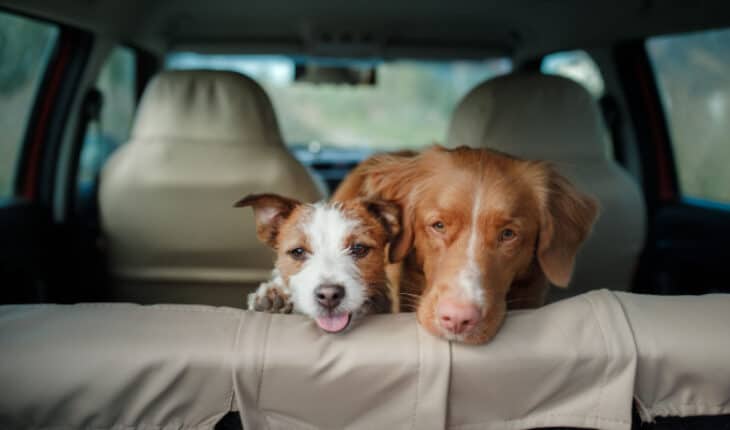As humans we all know we need to wear our seatbelts in the car and that moving around and distracting the driver can have devastating results – but what about your pet?
Unless your pet is safely secured for a journey in the car, they can pose a risk to you and themselves. Here’s how to ensure your pets are safe and comfortable whether it’s a short trip to the vets or a longer road trip. Failure to safely secure your pet, could also mean you are breaking the law.
Safety – yours and theirs
Even at just 30mph it has been calculated that an unrestrained Border Collie dog would be propelled forward in a collision, with a force equivalent to the weight of a polar bear.
Your safety: An unrestrained pet could seriously hurt you or your passengers in the event of an accident.
Pet safety: Therefore a pet seatbelt or carrier can help protect your pet from serious injury if you’re involved in a collision.
The law
The Animal Welfare Act 2006 means owners are responsible for the welfare of their animals, and this includes whilst they are in a car or another vehicle.
The Highway Code states that drivers must ‘make sure dogs and other animals are suitably restrained’ in your car. Failure to comply with this could mean you could be deemed to be driving without due care and attention. If you’re involved in an accident because you were distracted by your pet this could be deemed dangerous driving.
Preventing accidents: An unrestrained pet can get in the way of the steering wheel or the foot pedals in a car. They could distract the driver from the road and cause an accident.
Invalidate your insurance
Failure to properly restrain your pet may also invalidate your car insurance. Breaking the terms of your insurance could leave you with a huge bill to pay if an accident occurs. Your pet insurance may also be invalidated if they are injured and need treatment.
Preparation is key
Always plan your route, ensuring time for stops and factoring in contingency plans for delays.
Carefully consider the size and temperament of your pet and how much space they need to be comfortable when travelling.
Avoid travel if…
Unless you are taking your pets a short distance to your Vet, you should ideally avoid travelling with your pet if they are:
- Seriously injured, bleeding or vomiting.
- New born and or incapable of feeding themselves and not accompanied by its mother
- A pet that is heavily pregnant or has given birth within 48 hours of the journey
If you need to travel with your pet, they should be allowed to get completely comfortable with their environment. Allow them to sniff around in the car before your journey and find a comfortable place to sit. Put their favourite blanket or toy where you would like them to travel. If they are traveling in a travel crate, leave it accessible for them to get used to prior to putting it in the car. Encourage them to go in and out, put some of their favourite things inside and ensure it is not in any way intimidating for them.
Things you should always carry in your car
All cars should be equipped with a first aid kit. A human first aid kit is likely to contain articles that you can use to stop bleeding or administer first aid to your pet. Ideally you should have a pet specific first aid kit including specific pet chew-resistant bandages, a foil blanket to keep them warm and insulate them from the ground, gauze pads, saline and an absorbent mat to sit your injured pet on.
Before a long journey:
Toilet trips
Before setting off, encourage your pet to go to the toilet and have a quick run around the garden, go for a short walk or have some form of exercise.
Travel sickness
To avoid the risk of travel sickness, arrange for your pet to eat a couple of hours before travelling. Some animals can become more travel sick if they can see out of a window, so restricting their view might be a good option. If your pet suffers regularly from travel sickness, your vet might be able to prescribe anti-sickness medication.
Pet carrier or restraining harness
- Pet seatbelts
- Harnesses
- Crates and carriers
- Boot/luggage guards – however these protect passengers in an accident but won’t protect your pet
Many products on the market haven’t been crash tested. Therefore, if you want offer your pet the best protection, you might prefer one that has been properly crash-tested in controlled tests. Try the Centre for Pet Safety for certified tested products. Click here: https://www.centerforpetsafety.org
A pet carrier of an appropriate size for your pet offers the best protection for your pet and will reduce their chances of distracting you on your journey. They can also practice sleeping in the crate at home and quickly become comfortable and settled within it. Put their favourite blankets and toys inside and position it somewhere they like to be, leave it with the door open so they can wander in and out and become familiar and happy within it.
Secure the carrier safely within the car in case you turn a corner sharply or have to brake suddenly.
For larger animals such as big dogs, a carrier might not be appropriate. Instead you should consider a restraining harness, which can be attached to the car seatbelts to keep your dog safe.
During the journey
- Stop regularly to allow your animal to go to the toilet and get some fresh air.
- Ensure that your animal has easy access to drinking water, so they don’t become dehydrated.
- Take a supply of their usual pet food and favourite snacks, in case your journey is delayed.
- Never leave pets in the car on a hot day… the temperature inside a vehicle can be twice as high as that outside
- Keep animals cool by turning on the air conditioning or opening the windows furthest from the animal. Never drive with your animal’s head out of the window.
- Ideally, you shouldn’t leave pets in the car alone but, if it’s unavoidable, park in the shade and leave windows open on both sides of the car. Ensure this is never for more than very few minutes.
- What is a seizure? - 13th March 2025
- Febrile Convulsions and Seizures in Children - 13th March 2025
- Why women are less likely to receive CPR or survive cardiac arrest - 6th March 2025







